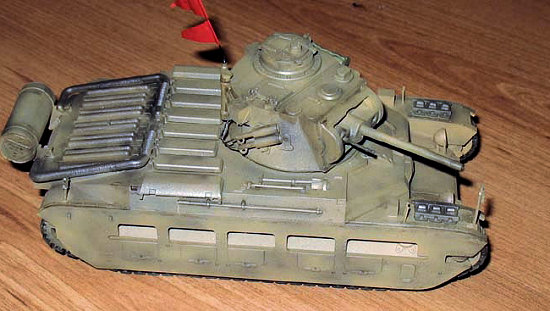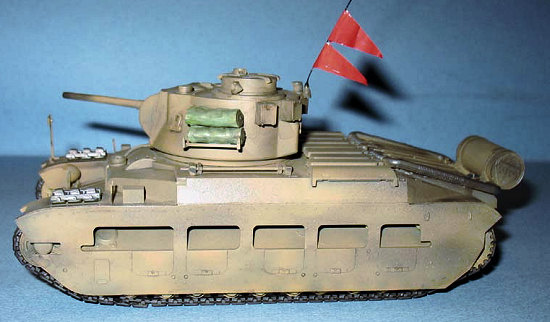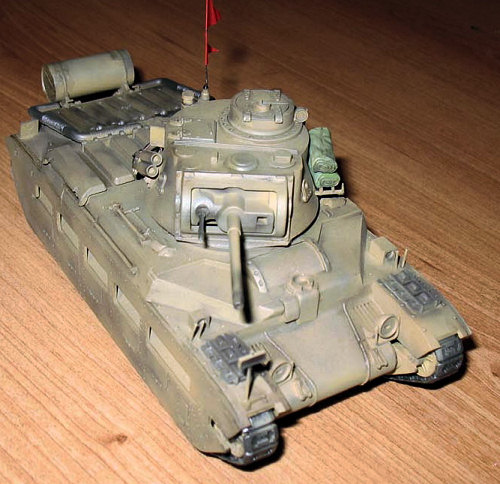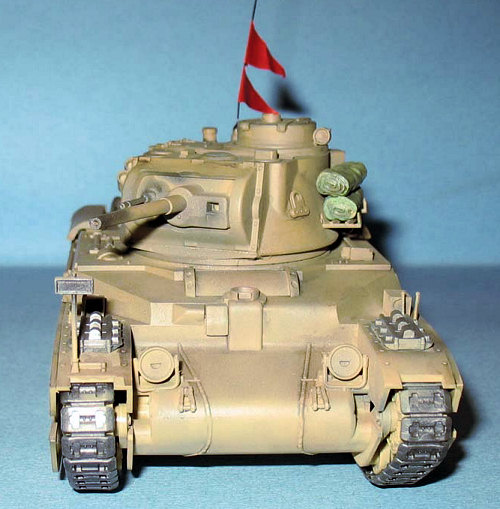
Tamiya 1/35 Matilda II
| KIT #: | 35024 |
| PRICE: | $24.99 MSRP |
| DECALS: | Two Options |
| REVIEWER: | Dan Lee |
| NOTES: | One of the oldest Tamiya Armor Kits which is only available in periodic production runs |

| HISTORY |
Chugging Matilda
The Matilda Infantry Tank was a product of flawed pre WW2 British Armored Doctrine which separated tanks into Cruisers and Infantry tanks (strange considering that Lidell Hart and JFC Fuller were theorist fathers of armor warfare.) The fast light Cruiser Tanks were to play the role of fast cavalry (scouting and striking) while slow heavy Infantry Tanks were designed to provide close fire support for infantry.
The Matilda (named for a cartoon duck and not someone’s Australian girlfriend) was all that was right and wrong about the Infantry tank. What was wrong with the Matilda was that it had a lousy armament (a 2pdr gun), a whopping cross country speed of 8mph (which was the top speed of an infantryman in a short sprint and considered good enough by the staid infantry generals who ran the Armor Branch) due to being powered by a bus (!) engine, and the turning ability of a sloth. What was right was that it was heavily armored (for the time) which allowed it to take a huge amount of fire without stopping—the heavy armor of the infantry tanks were what forced Rommel to improvise the use of the deadly 88mm AA guns to stop the British Armor charge at Arras.
In the 1940-1941 desert campaign,
the Matilda became known as the Queen of the Desert and was feared by the
Italians because it was impervious to their 37mm and 45mm AT guns. The Matilda became more and more vulnerable as AT weapon calibers
increased and had to face tanks with superior weapons, speed and
maneuverability. Another drawback was the Matilda could not up gunned to
handle bigger bore guns due to the small turret and was stuck with the now
useless 2pdr gun (40mm.) The tank was exported to the USSR and used for a
limited time period till it was replaced by infinitely better USSR made tanks
like the T-34 and KV-1. By the end of 1942, the Matilda was pretty much retired
in all theatres but the South Pacific and CBI (China Burma India) where it
remained in Australian service till the end of the war.
AT guns. The Matilda became more and more vulnerable as AT weapon calibers
increased and had to face tanks with superior weapons, speed and
maneuverability. Another drawback was the Matilda could not up gunned to
handle bigger bore guns due to the small turret and was stuck with the now
useless 2pdr gun (40mm.) The tank was exported to the USSR and used for a
limited time period till it was replaced by infinitely better USSR made tanks
like the T-34 and KV-1. By the end of 1942, the Matilda was pretty much retired
in all theatres but the South Pacific and CBI (China Burma India) where it
remained in Australian service till the end of the war.
The British Rommel
Richard O’Connor was born in India in 1889 into a military family. He graduated from Sandhurst in 1912 and soon found himself involved in WW1 first as a signals officer and as casualties mounted eventually commanded a brigade. He, like Erwin Rommel, was sent to Italy where he fought till the end of the war. In between wars, he spent a lot of time in training and staff courses. One of the more unusual posts he found himself in was as a commander for JFC Fuller while Fuller was developing and refining combined arms tactics which were refined by the Germans as Blitzkrieg. It was where Richard developed a good understanding of air power and armor tactics which he would later use in North Africa.
In 1940 General Richard O’Connor was assigned to command the Western Desert Force (eventually renamed 8th Army), consisting of the soon to be famous 7th Armored Division aka “The Desert Rats” and 4th Indian Infantry Division. He had pretty much the only British Army Combat command worthy of its name outside of Asia and they faced an Italian enemy that outnumbered him by at least five to one in men and material (36,000 men vs 200,000 men)
In Sept 1940, the Italian 10th (Cyrenaica) Army was ordered by Mussolini to attack Egypt, drive the Brits out and then capture the Suez Canal. At first, O’Connor was ordered to hold the Italians off and then counterattack to regain the Egyptian sand that was held by the Italians. O’Connor knew from his own observations and intelligence reports that the Italians were an army in name only (poorly led and trained) and decided to expand his attack beyond a local counter attack. He brilliantly maneuvered his units into position and struck while the Italians were asleep in their camps at Sidi Barrani. In a matter of hours, the Italian 10th Army was running for its life as the 7th Royal Tank Regiment’s Matildas destroyed the entire Italian front line armor force as well as decapitating the command and control (the invasion force commander was killed as he emerged from his bunker.)
The rest of the campaign was followed by similar attacks using shock, stealth and speed (a relative term considering the top speed of the Matilda tank, his best armor) as the Western Desert Force chased the Italians from Egypt all the way to Tripoli (O’Connor’s troops ended up capturing a total of 130,000 Italians, some 1200 guns and 1000 assorted vehicles for the relatively light losses of approximately 500 KIA and 1200 WIA.). O’Connor halted his columns and rested his troops while waiting for resupply (a necessity considering they had traveled some 800km and supply was unprepared for a sustained successful offensive operation.)
 In what could be considered a
Murphy’s Law moment, the halt in operations occurred in Feb 1941 just when Erwin
Rommel and the Afrika Korps arrived and just two months before Hitler decided to
invade the Balkans to aid the stumbling Italians who had been fighting the
Greeks since the Oct 1940. In one of Churchill’s dumbest moves (ranking up
there with Gallipoli and Dieppe), he forced General Wavell to send a large chunk
of O’Connor’s force (6th Australian Div and half of the 7th
Armored) and airpower that Wavell could not afford to spare to Greece which
collapsed within three weeks against the German juggernaut. This move
effectively delayed the end of the North Africa Campaign as there were no other
forces available to take the lost units place. This would not be the first time
nor the last time that soldiers were sacrificed for mere political points
instead of military necessity.
In what could be considered a
Murphy’s Law moment, the halt in operations occurred in Feb 1941 just when Erwin
Rommel and the Afrika Korps arrived and just two months before Hitler decided to
invade the Balkans to aid the stumbling Italians who had been fighting the
Greeks since the Oct 1940. In one of Churchill’s dumbest moves (ranking up
there with Gallipoli and Dieppe), he forced General Wavell to send a large chunk
of O’Connor’s force (6th Australian Div and half of the 7th
Armored) and airpower that Wavell could not afford to spare to Greece which
collapsed within three weeks against the German juggernaut. This move
effectively delayed the end of the North Africa Campaign as there were no other
forces available to take the lost units place. This would not be the first time
nor the last time that soldiers were sacrificed for mere political points
instead of military necessity.
To make matters worse for the British, Richard O’Connor was captured in mid April 1941 after a scouting mission (he was the rare general who led from the front and conducted his own battlefield reconnaissance) just when Rommel and his Afrika Korps were ready for desert operations. General O’Connor was held as a POW for two years till the surrender of Italy and he was liberated.
O’Connor later commanded British VIII Corps in Normandy and the Netherlands with varying degrees of success in Operation Dogwood and MarketGarden. He ended up being transferred to India at the end of 1944 where he ended the war which I suspect was in part to his suggestions to General Bernard “Monty” Montgomery during MarketGarden Among the ignored suggestions was one that O’Connor requested that his Corps flank Hell’s Highway (between Nijmegen and Arnhem) to force the Germans to take pressure of XXX Corps and/or provide a badly needed 2nd axis of attack to Arnhem—an unwelcome (for Monty) deviation from Monty’s plan (read the book or see the movie A Bridge Too Far to find out what happened to those who pissed off Monty and his friends by questioning various aspects of Operation MarketGarden.)
Richard O’Connor ended the war as a relative unknown compared to Montgomery although the scale of O’Connor’s victories in the Desert during 1940 and 41 were impressive (despite the poor showing by the Italian Army) considering he did it with scant resources relative to his opponent (the Italian Rodolfo Graziani, not Monty) and was similar to the successes that Rommel would have against the 8th Army and, later, the US II Corps for the early of Operation Torch.
Richard O’Connor retired from the army in 1948 and died in 1981.
Info from Wikipedia and my copy of Desert Generals.
| THE KIT |
 The Matilda Kit is one of Tamiya’s
older kits. I’ve read somewhere that it is dated from the late 60s, but my copy
of the kit was time stamped 1973 which is almost as old as I am.
The Matilda Kit is one of Tamiya’s
older kits. I’ve read somewhere that it is dated from the late 60s, but my copy
of the kit was time stamped 1973 which is almost as old as I am.
Thanks to the musty smell and yellowing of the box cardboard, I can safely assume that this kit is at least 25 years old and it does not look any different than any Tamiya armor kit I’ve seen. The parts have little flash, with ejection pin marks generally on the inside of parts and have nice fine detail.
This is one of those kits that had not been motorized so that there is no need to put sheet styrene to cover up holes where the motor drive shaft is supposed to go.
This particular kit was designed for the Japanese market as the instructions were entirely in Japanese which made things rather difficult for a non Japanese reader like me.
| CONSTRUCTION |
First step was to take some anti histamine to keep my dust/mold allergies from going crazy which started up after I opened the box. The next step was to wash off the mold release agents and any dust/mold on the parts.
I followed the kit instructions (Tamiya’s philosophy hasn’t changed much) with one a single issue. The only error in the instructions was the incorrect orientation of the top hatch in the instructions which Tamiya shows as opening up along the sides rather than the front/back.
 The turret was fairly straight
forward to assemble. I did use some Mr Surfacer 1000 and do some light sanding
to deal with the seam between the two major turret parts. The gun on the other
hand was awful. The main barrel itself was okay, but it was a smaller diameter
than the barrel muzzle piece. If I were so inclined I would have replaced it
with a resin or aluminum barrel, but I decided that I would use some modeling
skill instead. I ended up putting several layers of Mr Surfacer 1000 on the
barrel and then proceeded to sand till I got the pieces the same diameter. I
don’t put figures in my models (I suck at figure painting) so I buttoned up the
tank and kept everything closed.
The turret was fairly straight
forward to assemble. I did use some Mr Surfacer 1000 and do some light sanding
to deal with the seam between the two major turret parts. The gun on the other
hand was awful. The main barrel itself was okay, but it was a smaller diameter
than the barrel muzzle piece. If I were so inclined I would have replaced it
with a resin or aluminum barrel, but I decided that I would use some modeling
skill instead. I ended up putting several layers of Mr Surfacer 1000 on the
barrel and then proceeded to sand till I got the pieces the same diameter. I
don’t put figures in my models (I suck at figure painting) so I buttoned up the
tank and kept everything closed.
The main hull of the tank was a little more problematic. The parts were not warped despite its age, but I had a hard time fitting the bottom and top halves together. The many open gaps were ignored because the Matilda’s track guards cover it all up.
The only seams I did have to fill were those located in the front part of the hull which I used some Mr Surfacer and CA glue and some light sanding.
The next was the somewhat tedious task of building the bogies (?) and road wheels. I didn’t bother to clean them up as most of the mechanism would be covered up by the track guards.
Last but not least was the exhaust and external fuel tank which required some filling and sanding. This was a touch less tedious than the gun, but it went without too much trouble.
Again, everything that went into the hull was closed up and I left off the parts that were different in color to the hull including the tracks.
| COLORS AND MARKINGS |
Painting
I used the modeler’s best friend, Google, to find out what the actual color the British used for their tanks. It was something called Light Stone which IPMS Stockholm claimed that XF-60 was a close match. When I did a comparison with MM colors, the MM Acryl Light Stone was closer to XF-59, Desert Yellow. As I did have XF-59, I decided to use XF-59 and the color police can shoot me later for it.
I preshaded the tank with light grey and dark green before spraying on the Desert Yellow for the base color. One thing one must remember when air brushing a preshaded model is to spray the base color in thin coats to allow the preshading to come out.
The exhausts were painted with combination of Citadel Chainmetal mixed with Mig Red Soil to get the worn out look.
| FINAL BITS |
The rubber tracks were installed
(glued together with CA glue) and then the track guards were added. I opted to
fill in the seams a  bit with Mr Surfacer 1000 and the excess removed with Mr
Thinner rather than sanding because I didn’t want to remove the rivet detail. I
then repainted the damaged areas so I could do a water color wash. I used burnt
sienna only to highlight details.
bit with Mr Surfacer 1000 and the excess removed with Mr
Thinner rather than sanding because I didn’t want to remove the rivet detail. I
then repainted the damaged areas so I could do a water color wash. I used burnt
sienna only to highlight details.
Decals, Wash and Final Coat
The 34(?) year old decals were tossed in the trash. I googled for 7th RTR photos on the internet and asked around on the forum for markings. At least from the photos I’ve seen of the 7th RTR during Operation Compass, the Matildas did not carry any markings or unit flashes/badges. Only identification markings that I could see were triangle flags on the radio mast (I took a big giant leap by assuming they’re red.) When I attached the steel antenna to the radio mast mount, I cut two triangle pieces of aluminum foil, painted them red and attached them to the mast with Micro Metal Foil Adhesive.
I ended up using a watercolor wash of burnt sienna and a touch of raw umber to dirty up the tank and it was sealed with Gunze Flat. A final coat of Poly S dust was sprayed on to add a last layer of “dirt.”
I then added all the parts I left off prior to painting and I was done.
| CONCLUSIONS |
The Tamiya Matilda is the only 1/35 scale model of this early war tank that I know of and makes a nice out of the box build. It does have some accuracy issues according to armor gurus, but being an armor detail ignoramus I couldn’t tell you what they are.
July 2007
Copyright ModelingMadness.com
If you would like your product reviewed fairly and fairly quickly, please contact the editor or see other details in the Note to Contributors.